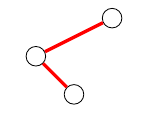Queries for Binary trees: search statistic / browse statistics / browse maps from / browse maps to
Definition & Example
-
A binary tree is a rooted tree where each node is either internal (has two children) or is a leaf (has no children).
-
Equivalently, a binary tree is recursively defined to be either an empty tree (leaf) or an ordered pair of binary trees (internal node).
| the 5 Binary trees of size 3 | ||||
 |
 |
 |
 |
 |
| [.,[.,[.,.]]] | [.,[[.,.],.]] | [[.,.],[.,.]] | [[.,[.,.]],.] | [[[.,.],.],.] |
-
The graphical representation omits the leafs and only shows the internal nodes.
-
There are $\operatorname{Cat}(n) = \frac{1}{n+1}\binom{2n}{n}$ binary trees with $n$ internal nodes, see OEIS:A000108.
Additional information
Feel free to add further information on the combinatorics of binary trees here!
References
Sage examples
Technical information for database usage
- A binary tree is uniquely represented as a dot (empty tree) or as a sorted list of binary trees.
- Binary trees are graded by the number of internal nodes.
- The database contains all binary trees of size at most 8.
If you want to edit this wiki page, you can download the raw markdown and send your new version to info@findstat.org